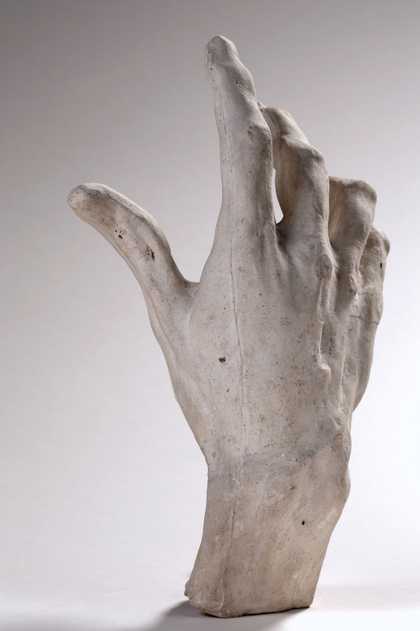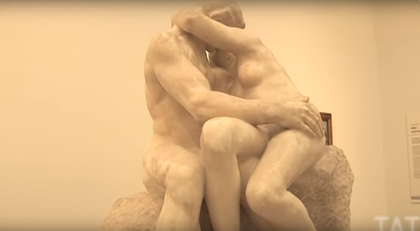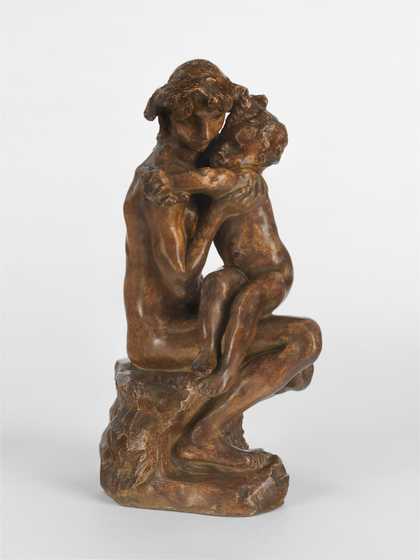
View of the Pavillon de l’Alma in Meudon around December 1906. Photo by François Vizzavona, Musée Rodin
French sculptor Auguste Rodin was born in Mouffetard, a working-class district of Paris, in 1840. After repeated rejection from the Ecole des Beaux-Arts in Paris, he worked as an assistant in decorative art studios for many years. During this time he learnt how to get the most out of a single sculpture, casting multiple copies and reworking each one. He applied these lessons to his own studio work – dismantling and reassembling existing sculptures in endless combinations. This allowed him to alter the overall composition without having to remake the whole sculpture. This became an ongoing feature of Rodin’s work and set him apart from his contemporaries.
I began as an artisan to become an artist. That is the good, the only, method.
Auguste Rodin
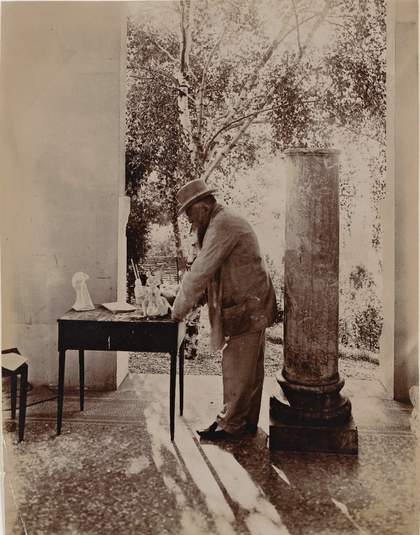
Rodin working under the peristyle of the Pavillon de l’Alma in Meudon c.1912. Photo by Jean Limet
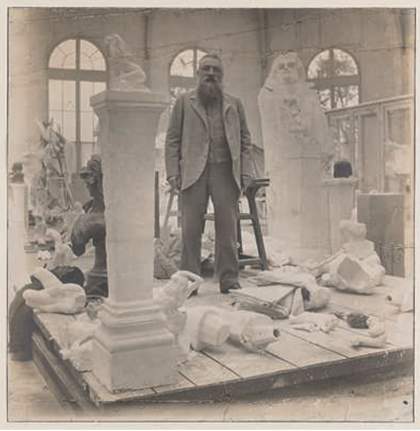
Rodin in his studio in Meudon c.1902. Photo by Eugène Druet, Musée Rodin
In 19th century France, sculptures were expected to be presented in their entirety, with the exception of portraits busts. Although Rodin was trained in this tradition, as his practice developed, he began to question the conventions of classical sculpture. He embraced the visible traces of his works creation, believing the ‘process’ to be as significant as the finished form. Pristine surfaces were gouged with fingerprints and nail marks. Traces of modulation, including seam lines were left clearly visible. He also experimented with the proportions of his figure’s bodies, distorting the length and scale of their limbs. Plaster played a central role in the development of his new aesthetic, as seen in works such as The Thinker, Helen Von Nostitz and The Three Shades.

Rodin in front of his collection of antiques circa 1910, [Ph.00007] Photo: Albert Harlingue, Musée Rodin.
![Françoise Vizzanova Rodin’s collection of antiquities at Meudon, Musée Rodin. [PH.6135]](https://media.tate.org.uk/aztate-prd-ew-dg-wgtail-st1-ctr-data/images/rodins-studio-with-antiquities.width-420.jpg)
Rodin’s collection of antiquities at Meudon. Photo: Françoise Vizzanova, Musée Rodin. [Ph.6135]
In 1893, by now an established sculptor, Rodin left Paris for a place where he could live a more simple life and be closer to nature. He settled in Meudon, an area just outside of Paris and bought the Villa des Brillants. A place where he lived, worked and displayed his collection of over 6000 antiques, this home became something of a ‘house-museum’.
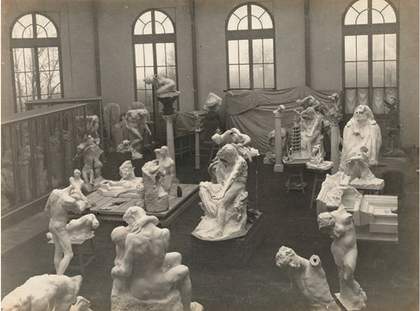
View of Rodin’s studio 1904–5. Photo by Jacques-Ernest Bulloz, Musée Rodin
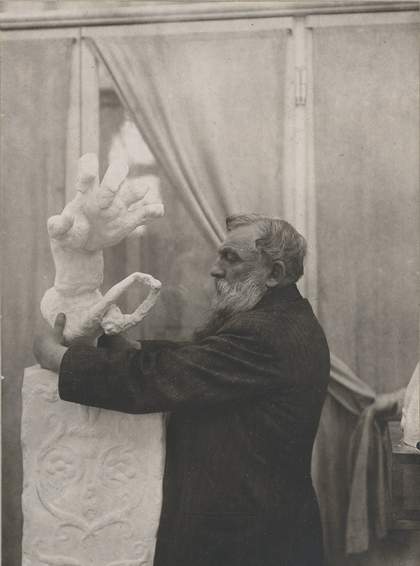
Rodin placing the plaster Clenched Hand with Imploring Figure on a pedestal, in the Pavillon de l’Alma, Meudon 1906. Photo by unknown photographer, Musée Rodin
Sculpture is the art of the hole and the lump, not the straightness of smooth faces without modelling
Auguste Rodin
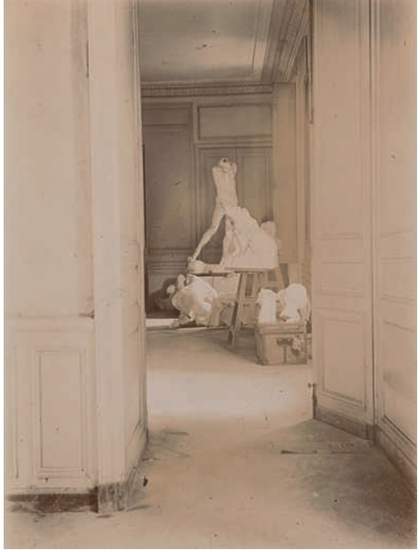
View of Rodin’s studio c.1896. Photo by Eugène Druet, Musée Rodin
In 1900, Pavillon de l’Alma was built in central Paris as a venue to host Rodin’s first solo exhibition. With sculptures from throughout his career clustered around the space, including Balzac and The Inner Voice, it was like walking through the artist’s studio. This idea was reinforced by Rodin’s decision to exhibit plaster versions of his work, rather than the marble or bronze casts that he was best known for. The exhibition turned Rodin into an international star and the following year, he had the building re-erected in his garden in Meudon. This mostly glass structure became his studio and provided him with a space where he could continue to develop his work in plaster, allow his models to move freely and collaborate with a team of up to twenty different technicians at any given time. Friends, models and commissioners would visit Rodin in Meudon and gain a better understanding of his practice. Iconic works such as The Burghers of Calais were presented alongside lesser known studies. As one visitor described;
One doesn’t need to look around for long to know that one is in a working environment, with a worker obsessed by his thoughts, almost indifferent to the world outside.
Visitors to the Villa des Brillants included King Edward VII of Great Britain, First Lady of the United States, Edith Kermit Roosevelt and photographer Edward Steichen.
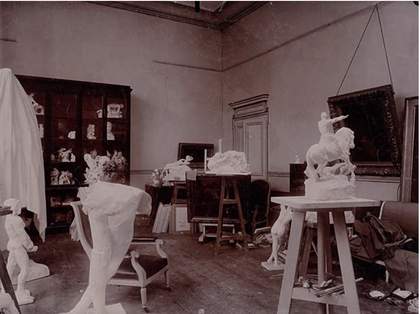
View of the studio of the Villa des Brillants n.d. Photo by unknown photographer, Musée Rodin
Any artist worthy of the name should express all the truth of nature, not only the exterior truth, but also, and above all, the inner truth
Auguste Rodin
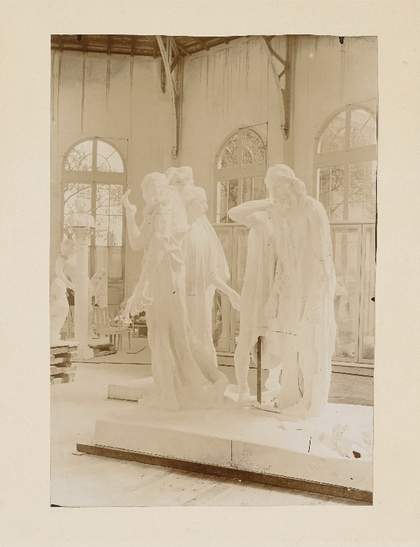
Monument to the Burghers of Calais in the studio at Meudon c.1902. Photo by Jean Limet, Musée Rodin
I have invented nothing; I only rediscover
Auguste Rodin
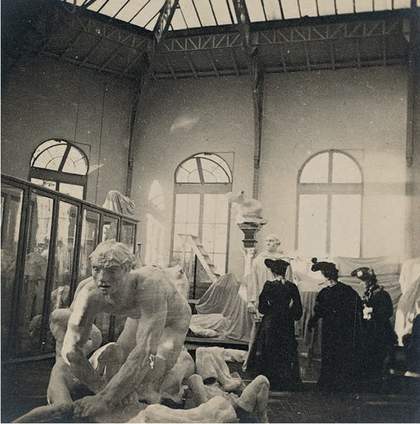
Three women visiting Rodin’s workshop c.1901 Photo by Jules Richard, Musée Rodin
Rodin lived at the Villa Des Brillants until his death in 1917. He is buried in the garden, next to the re-erected Pavillon d’Alma and the home is now a museum.
See The EY Exhibition: The Making of Rodin at Tate Modern 18 May – 21 November 2021

